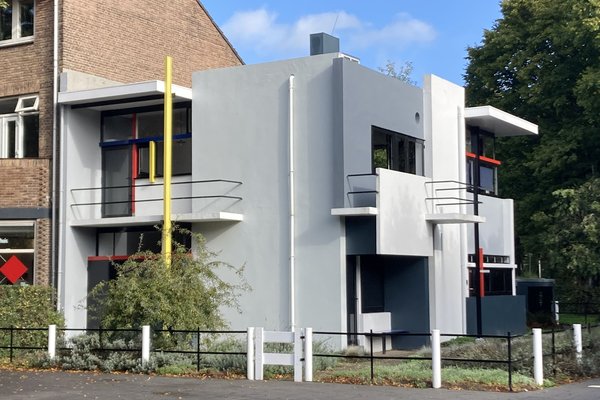Netherlands
Rietveld Schröderhuis
The Rietveld Schröderhuis is considered an icon of the Modern Movement in architecture.
The house was constructed in 1924 by the famous artist Gerrit Rietveld. It was his first attempt at designing a complete house. He got the assignment from Mrs. Schröder, and together they developed this unique house. It was built according to the architectural principles of the "Stijl"-movement: only the typical colours red, blue and yellow are used, in combination with the non-colours white, grey and black. The furniture inside was also made by Rietveld, in the same style and colours.
Community Perspective: quite expensive to visit (19 EUR in 2023) and incredibly small. But “even if you are not a big devotee of Modernist architecture, it is worth the time to see inside, the huge amount of ingenious small details are enough to keep most people entertained.” Read Ian’s review for more about the De Stijl movement. Recently (2022), they’ve eased visitor conditions by allowing photography and providing access with an audio guide instead of a tour.
Site Info
Official Information
- Full Name
- Rietveld Schröderhuis (Rietveld Schröder House) (ID: 965)
- Country
- Netherlands
- Status
-
Inscribed 2000
Site history
History of Rietveld Schröderhuis
- 2000: Criteria
- The application of criterion (vi) was deferred, pending the report of the meeting "Authenticity and Integrity in the African Context" which was recently held.
- 2000: Inscribed
- Inscribed
- Type
- Cultural
- Criteria
- i
- ii
Links
- UNESCO
- whc.unesco.org
- Official
-
- centraalmuseum.nl — Museum website
- Related
-
- worldheritagesite.org — Rietveld Bike Tour through Utrecht
- spiegel.de — Das Ufo von Utrecht
- archdaily.com — Archdaily Classics: Rietveld Schroder House / Gerrit Rietveld
All Links
UNESCO.org
- whc.unesco.org — whc.unesco.org/
Official Website
- centraalmuseum.nl — Museum website
Related Resources
- worldheritagesite.org — Rietveld Bike Tour through Utrecht
- spiegel.de — Das Ufo von Utrecht
- archdaily.com — Archdaily Classics: Rietveld Schroder House / Gerrit Rietveld
- en.wikipedia.org — Wikipedia on Gerrit Rietveld
- greatbuildings.com — Schroder House by GreatBuildings.com
News Article
- Feb. 14, 2014 nieuws.nl — Rietveld Schröderhuis imitated in Lego
Community Information
- Community Category
- Secular structure: Residence
Travel Information
Reservation required
WHS Commandments Stars
Amsterdam hotspot
Recent Connections
-
Perfect Inscriptions
2000 -
WHS Commandments Stars
Scores on all except #8, no paper ticke… -
Translated Toponyms
"Huis" is Dutch for House. Translation …
Connections of Rietveld Schröderhuis
- Trivia
-
-
Smallest cultural WHS
"The Schröder House measures about 7m x 9m, and it has two floors" (AB ev) - 0.00750 ha.
-
- Architecture
-
-
International style
De Stijl, a Dutch art movement: "The works of De Stijl would influence the Bauhaus style and the international style of architecture as well as clothing and interior design. However, it did not follow the general guidelines of an "-ism" (e.g., Cubism, Futurism, Surrealism), nor did it adhere to the principles of art schools like the Bauhaus; it was a collective project, a joint enterprise." (wiki)See en.wikipedia.org
-
Reinforced Concrete
"The main structure consists of reinforced concrete slabs and steel profiles." (AB ev)
-
- Damaged
-
-
Damaged in World War II
"During World War II a lorry carrying ammunition exploded on the ring road not far from the house. All the windows were shattered and cracks appeared in the masonry of the south wall. The windows were repaired, but with some differences compared to the originals. (AB ev)
-
- World Heritage Process
-
-
Single Monuments
Also meets criterion i: masterpiece of human creative genius. -
Perfect Inscriptions
2000
-
- Constructions
-
-
Chairs
The “Red and Blue Chair” designed by Gerrit Rietveld in 1917 and was orogonally “uncoloured”. In 1923 it was painted “entirely black with areas of primary colors attributed to De Stijl movement. The effect of this color scheme made the chair seem to almost disappear against the black walls and floor of the Rietveld Schröder House, where it was later placed” (Wiki).See en.wikipedia.org
-
- Timeline
-
-
Built in the 20th century
Built in 1924 (AB ev)
-
- WHS Hotspots
-
-
Amsterdam hotspot
Located in a residential area in Utrecht, about 1h from Amsterdam Central Station by train & bus
-
- Visiting conditions
-
-
Reservation required
To be done online, 1 or 2 days before usually is enough. -
Shoe covers required
-
WHS Commandments Stars
Scores on all except #8, no paper tickets
-
- WHS Names
-
-
Named after individual people
Mrs. Truus Schröder-Schräder -
Translated Toponyms
"Huis" is Dutch for House. Translation in English in the full name.
-
News
- nieuws.nl 02/14/2014
- Rietveld Schröderhuis imitated in …
Recent Visitors
Visitors of Rietveld Schröderhuis
- Adrian
- Adrian Turtschi
- Alexander Barabanov
- Alexander Lehmann
- Alexander Parsons
- Alex Baranda
- A. Mehmet Haksever
- Ammon Watkins
- Ana Lozano
- Antonio J.
- Argo
- ArnaudFilloux
- Ask Gudmundsen
- Aspasia
- Assif
- Astraftis
- Atila Ege
- Avery MC
- Badwater
- Bamse
- basementonline
- BaziFettehenne
- bethready
- Bill Maurmann
- Bin
- BobSmithseestheworld
- Bram de Bruin
- Brendan Carroll
- Can SARICA
- Caspar
- Cezar Grozavu
- Chantal den Haan
- chenboada
- Christer Sundberg
- christof
- Christoph
- Christravelblog
- Claire Bradshaw
- Clyde
- Colossus
- Coppi
- crilly
- Cristina Erba
- Csaba Nováczky
- Dagmara
- Damientournay
- Daniela Hohmann
- Daniel Chazad
- David Aaronson
- David Berlanda
- DavidS
- Dimitar Krastev
- Dimitrios Polychronopoulos
- Dirk-pieter
- Dolemite92
- Dorejd
- Doubanjiang
- Dr. Caligari
- Dwight Zehuan Xiao
- Echwel
- Elis
- Els Slots
- Enid MC
- erdsaumnaht
- Erik Jelinek
- Errol Neo
- Eva Kisgyorgy
- Evgenii
- Fan Yibo
- Farinelli
- Federico P.
- Feldhase
- Felicité
- Femke Roos
- Fernweh
- Flexiear
- FrankW
- Frederik Dawson
- FS
- Galgalula
- Gary Arndt
- Geert Luiken
- George Gdanski
- GeorgeIng61
- Hadrianus
- Harry Mitsidis
- Hdhuntphotography
- heywhatever2
- Hubert
- Iain Jackson
- Ian Cade
- Ilya Burlak
- Ingrid
- Ivan Rucek
- Jacob Choi
- Jakob F.
- Jana and Matt
- Janina Lehmann
- janis
- Jan-Willem
- Jan Zimmermann
- Jarek Pokrzywnicki
- Jasam
- Jawnbeary
- Jay T
- Jeanne OGrady
- Jens
- Jezza
- J_neveryes
- Joel on the Road
- Jonas Hagung
- Jonas Kremer
- jonathanfr
- Jon Eshuijs
- jonstst
- Joyce van Soest
- Jurre
- KarenBMoore
- Kasia M.
- Kbecq
- Ken DJ
- Klaus Freisinger
- Knut
- Krijn
- Kristin
- Kurt Lauer
- Lara Adler
- Laurey
- leroykstlj
- Lisu Marian
- Lucio
- Luis Filipe Gaspar
- Lukasz Palczewski
- Maciej Gil
- Maciej Gowin
- Mahuhe
- marcel staron
- Martin
- Martina Rúčková
- Mathijs
- MaxHeAnouBen
- MaYumin
- MH
- M. Huineman
- Michael Novins
- Michael Turtle
- Mihai Dascalu
- Mikko
- Mikko Syrjä
- Miloš Tašković
- Mo-han Je
- Mohboh
- Monica Tasciotti
- MoPython
- Mstrebl1990
- nan
- Nasebaer
- Nicole Lampos
- Nihal Ege
- NoahFranc
- PabloNorte
- Patrik
- Paul Schofield
- PeterH
- Peter Lööv
- Petteri
- Philipp Leu
- Philipp Peterer
- Pieter Dijkshoorn
- Piotr Wasil
- Porcho
- Rafał Kałczuga
- Rahelka
- Ralf Regele
- Randi Thomsen
- ReallyDeepThoughts
- Reza
- Rick Ohm
- Rodinia
- Roel Sterken
- Roger Ourset
- Roman Bruehwiler
- Roman Raab
- Ronbon
- Rudegirl
- Sabrina Liebehentschel
- Sandmann15
- Sandra!
- SDMArado
- Sebasfhb
- serghei.belous
- Sergio Arjona
- Shandos Cleaver
- shwabb1
- Simonh
- SirLoydd
- Slavi
- sncjob
- Solivagant
- Squire Sullen
- Stanislaw Warwas
- stephanvermeulen
- Stijn
- Svein Elias
- Szucs Tamas
- Tamara Ratz
- Taotao Chen
- Tarquinio_Superbo
- Tatiana Nikulnikova
- Ted Coombs
- Tevity
- Thomas Buechler
- Thomas Harold Watson
- Thomas van der Walt
- Thorben
- tony0001
- Tony H.
- triath
- Tsunami
- usagi1974
- Vanessa Buechler
- Veronica
- WalGra
- Walter
- Westwards
- WILLIAM RICH
- Wojciech Fedoruk
- Wo_ko
- YaroMir
- Yevhen Ivanovych
- Yi Han Goh
- Yongcheng Liu
- Zach
- Zhenjun Liu
- Złoty Tłok Czesław
- Zoë Sheng
Community Reviews
Show full reviews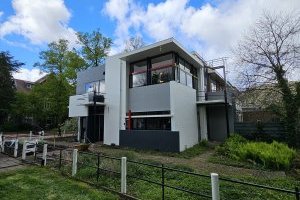
I was visiting Utrecht University back in 2010 and to get to the university from my accommodation I cycled past Rietveld Schröderhuis daily. Unfortunately I didn't have time to visit it back then and it always bothered me how near miss this site was for me. But luckily in April 2024 I had finally chance to visit the house properly. I had pre-booked the house tour online and I arrived 15 minutes before my time slot. While waiting for the tour to start I was guided to watch a film about the house and interview of Truus Schröder-Schräder where she described how the life was in the house. I found the film very interesting and good introduction before the actual tour.
The tour around the house is self-guided audio tour. You first walk around the downstairs before moving up to the second floor. The whole house is full of fun details that were many times ahead of its time. You'll understand fast why this house was so groundbreaking in architecture and why it's a WHS now. When everyone in your group are upstairs the guide will demonstrate how the walls move. We got to see how the walls open and create a spacious room with lots of natural light. The group after us then got to see how they close the walls creating smaller rooms that were the bedrooms of Schröder's children. The transformation of space is amazing. You are otherwise allowed to photograph inside the house but you're …
Keep reading 0 comments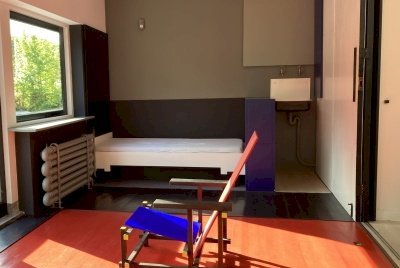
Together with Philipp, I recently revisited the Rietveld Schröderhuis. Since this was 21 years after my first visit and many of its reviews on this website are quite old, I’d like to share some updated perspectives. Modern architecture often makes me sad (looking at you, Le Corbusier!), but we left this house with a smile on our faces.
This is one of the best-rated WHS in the Netherlands. I think it should be valued even more considering the exemplary visitor experience the Utrecht Central Museum (which exploits the Rietveld Schröderhuis) provides nowadays. You have to book your time slot online at their trilingual website to be able to visit the house. Usually, you’ll be fine a week beforehand, but be aware of busy periods such as (school) holidays. The 19 EUR entrance fee is steep but considering the low number of visitors that this building can handle, I think it is reasonable to cover the costs.
We arrived by car and easily found parking in the street near the viaduct. It has to be paid via a parking meter.
While the visit used to be via a guided tour (at least until 2010, gathering from earlier reviews), now it is by an audio guide. Mine occasionally faltered but was nevertheless informative as it points you to the details – and there are many quirky ones in this house. There are still guides present in person at the house to answer questions and of course to perform …
Keep reading 0 comments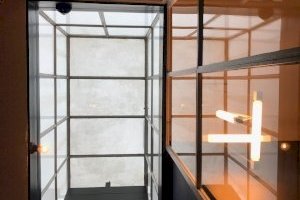
The Rietveld Schröder House is one of those really nice sites that make an interesting visit but that are at the same time so small that you can see them quite thoroughly in one or two hours. I went to Utrecht from Amsterdam. There is train several times an hour. From Utrecht Centraal you take tram number 8 to De Hoogstraat and walk five minutes. There you find a visitor centre in the house next to the RSH with nice books, souvenirs, bathrooms and an interesting movie about the creation of this house. You can certainly also buy tickets here but I would recommend to buy a ticket online in advance. Tickets seem less scarce then in the Villa Tugendhat in Brno that is sold out for month but it would still be a pity to travel here and find no ticket since you can visit the house only with a tour.I found the movie and the tour very much worthwhile since you learn a lot about the creation of the house. Normally you read that Schröder was the rich lady who paid Rietveld to build a house for her and her three kids. It seems the truth is much more complicated and more interesting: She was supposedly a kind of interior architect herself and when Rietveld presented her his first draft she didn’t like it. She had obviously a great influence on the shape of the house and on the revolutionary open space on the first floor. It seemed …
Keep reading 0 comments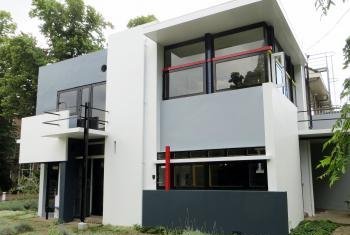
I'm glad the Rietveld Schröder House is a World Heritage Site because not only is it an impressive piece of architecture, it also introduced me to the wonderful city of Utrecht. It is unfortunate photography is not allowed inside the Rietveld Schröder House, because the exterior does not do justice to the interior's inventive use of space. Downstairs the house is divided into rather traditional rooms, such as a kitchen and a studio. Upstairs, however, is an open floor plan which can be cleverly subdivided into rooms by movable panels. Gerrit Rietveld employed De Stijl principles when creating the architecture and furniture of the house, which give the house a clean, functional style. The Centraal Museum has an exhibit on Rietveld's furniture designs, and I'm glad I had seen the exhibit prior to visiting the house in order to further appreciate his work. There is much to recommend in Utrecht beyond the Rietveld Schröder House and the Centraal Museum -- I highly enjoyed the Dom Tower (which has incredible views), the medieval center of the city with its walls and churches, and the scenic Oudegracht, a canal in the heart of the city, when I visited two years ago.
Logistics: Although you can rent a bike or take a bus to get to the Rietveld Schröder House, I highly enjoyed the walk from the Centraal Museum, where the tour tickets are sold.
Keep reading 0 comments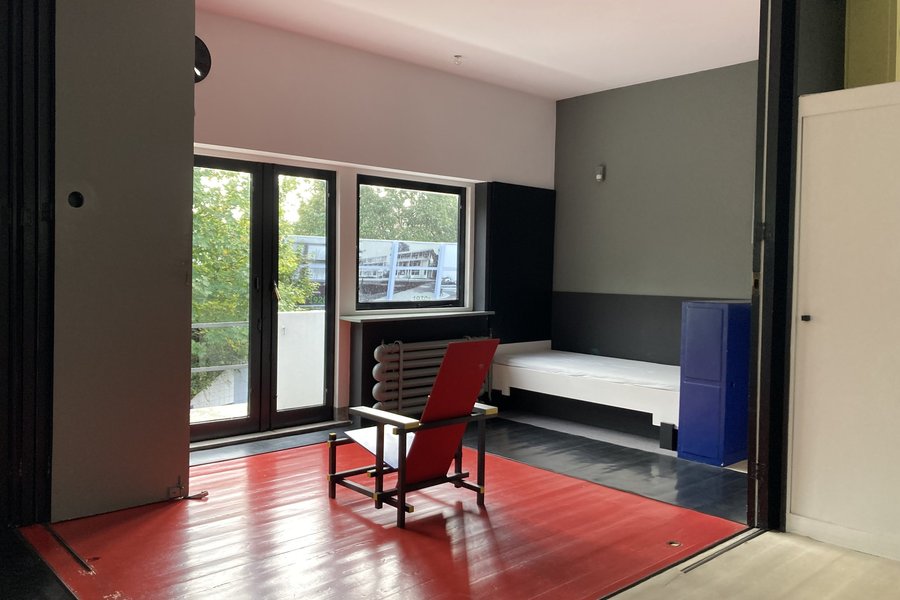
I visited the Rietveld house in July 2015. It's really interesting with the rest of the houses there to see the contrast. Thinking away the highway as it was built before that was there.
How the upper floor is changed into the seperate rooms is just amazing. I like also the prime colors everywhere and the links and that everything is together.
I would like to have a house like this now, but a bit bigger probably and modernized (more automatic).
on the link below my photos. Did a few inside to, which was actually not allowed.
Keep reading 0 comments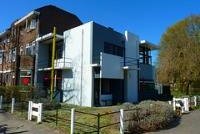
Having read the reviews on this site I decided to visit the WHS without doing any research. The exterior was quite 'normal' although that should have already been a good enough indicator of what to expect inside! What looked 'normal' now was actually built in the 1920s! I had made a reservation online and I collected my ticket from the central museum. They give you an audio guide and shoe cover-ups to wear over your shoes inside the house. The interior of this house is nothing short of a genius' creation. The entrance fee is quite expensive (14.50e!) and you cannot take photos inside but I found the visit to be truly worth it. I'm no architecture geek but I was utterly amazed by the interior of the Schroder House. This is surely my favourite WHS in the Netherlands!
Keep reading 0 comments
I visited the Rietveldt-Schroder house on a cold windy morning a year ago by taking a #4 bus from Utrect Central station to Hoogstraat and walking down Prins Hendriklaan. I bought a ticket (8 euros, 6 for over 65s) at the visitor centre around the corner from the house and took a tour of the house using a recorded commentary in English.
Keep reading 0 comments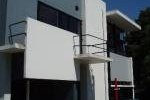
I really enjoyed visiting this site; it was my favourite World heritage site in the Netherlands. Twentieth century/ Modern architecture has turned into something of a special area of interest for me and as such this house really impressed me.
One of the first things that strikes you about the house is how small it actually is, and also how radically different it is from the other houses on the road. In fact I would suggest that this is one of/ if not the smallest world heritage site, defiantly the smallest I have visited.
I did a little bit of background reading before my visit to get some insight into the De Stijl movement, which produced the exceptionally clear but somewhat Utopian principles from which this house developed.
Rietveld was a carpenter by trade and is famous for the stools he created; especially the Red and Blue Stool, there are many criticisms’s of these though as being more sculptures than practical objects. They are seen as Utopian as the straights lines and angels are not designed for a human body, but for an ideal of what the body should be. I was expecting the house to be very similar; however the very close collaboration between the architect and client has led to this being a hugely practical house. The huge amount of ingenious small details and contraptions are the result of Rietveld’s background as a carpenter making everyday items and the need to make the house a practical machine for …
Keep reading 0 comments
A few years ago I visited the Rietveld Schroderhuis, and even though it's quite expensive to visit, I am glad I did it. At the tour they gave (you are not allowed to wander around by yourself) they told us a lot of info and it turned out the house had a lot of nifty things that you probably wouldn't have noticed yourself. When you visit the house, make sure you also visit the Centraal Museum (not too far away from the house, make sure you buy a combination ticket; it'll safe you money) where they also have a lot of furniture from Rietveld on display.
Keep reading 0 comments
Modern architecture is not really my cup of tea, but a trip to Amsterdam in winter doesn´t leave you many options for nearby WH sites, and since Utrecht is just about 30 minutes by train, I thought I´d give it a try, and it was actually quite nice. Utrecht is a pleasant and historically important city with a big cathedral and a belfry, and the well-organized, but rather expensive tour from the Central Museum doesn´t require much organizing. I guess I wouldn´t have found this out-of-the-way building on my own, anyway. The architecture has been described in great detail here, so everybody will know by now that this house is incredibly small (yes, I can´t imagine that there would be a smaller WH site, either), but very well planned and constructed, with lots of small details you couldn´t notice yourself. So it was a nice outing on an untypically pleasant winter day, and since it was my personal 100th WH site, there was nothing I could complain about.
Keep reading 0 comments
I like the efficiency of space in the house and impressed by the detail touch of the designer inside the house that showed how smart and thoughtful he was. The house is very contrast with other houses in the area, which makes it very unique. Unfortunately the highway ruined the initial beautiful view and landscape surroundings.
Keep reading 0 comments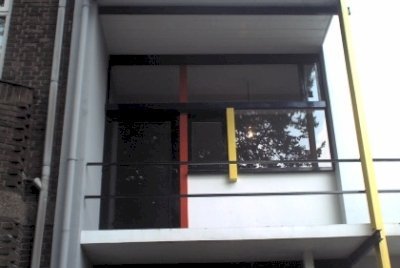
Mrs. Schröder lived in this house until she died in the 1980s. Nowadays it is open to the public and you can visit it on a guided tour.
The most remarkable aspect is that when Rietveld built this house, it was situated on the outskirts of the city of Utrecht. Only one year later a four-lane motorway was developed next to it, ruining both the sight and the quietness. Rietveld and Mrs. Schróder must have been devastated by this.
I took the tour with my mother, and we both thought it was very worthwhile. There are so many little ingenious aspects of the house that it's amazing. And to think that it was built in 1924, what a revolution it must have been at the time.
Keep reading 0 comments
